
Illustrative Math Alignment: Grade 7 Unit 7
Angles, Triangles, and Prisms
Lesson 10: Drawing Triangles (Part 2)
Use the following Media4Math resources with this Illustrative Math lesson.
| Thumbnail Image | Title | Body | Curriculum Nodes |
|---|---|---|---|
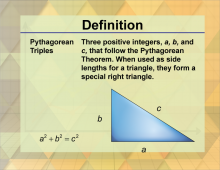
|
Definition--Triangle Concepts--Pythagorean Triples | Pythagorean TriplesTopicTriangles DefinitionPythagorean triples are sets of three positive integers that satisfy the Pythagorean theorem: a2 + b2 = c2 DescriptionPythagorean triples are sets of three positive integers that satisfy the Pythagorean theorem, which states that in a right triangle, the square of the hypotenuse is equal to the sum of the squares of the other two sides. Common examples include (3, 4, 5) and (5, 12, 13). |
Definition of a Triangle |
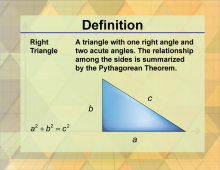
|
Definition--Triangle Concepts--Right Triangle | Right TriangleTopicTriangles DefinitionA right triangle is a triangle with one 90-degree angle. DescriptionA right triangle is a type of triangle that has one angle measuring 90 degrees. This type of triangle is fundamental in geometry and trigonometry, as it forms the basis for the Pythagorean theorem: a2 + b2 = c2 This concept is essential in various real-world applications, such as in construction and navigation. For example, right triangles are used to create right angles and ensure accuracy in building projects. They also play a crucial role in various mathematical problems and proofs. |
Definition of a Triangle |
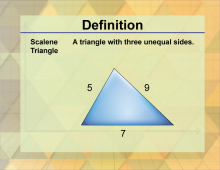
|
Definition--Triangle Concepts--Scalene Triangle | Scalene TriangleTopicTriangles DefinitionA scalene triangle is a triangle with all three sides of different lengths and all three angles of different measures. DescriptionA scalene triangle is characterized by having all three sides of different lengths and all three angles of different measures. This type of triangle is significant in geometry as it represents a unique class of triangles with specific properties. |
Definition of a Triangle |
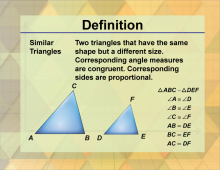
|
Definition--Triangle Concepts--Similar Triangles | Similar TrianglesTopicTriangles DefinitionSimilar triangles are triangles that have the same shape but not necessarily the same size, with corresponding angles equal and corresponding sides proportional. DescriptionSimilar triangles are fundamental in geometry, representing triangles that have the same shape but not necessarily the same size. This means that all corresponding angles are equal, and all corresponding sides are proportional. |
Definition of a Triangle |
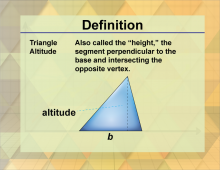
|
Definition--Triangle Concepts--Triangle Altitude | Triangle AltitudeTopicTriangles DefinitionThe altitude of a triangle is a perpendicular segment from a vertex to the line containing the opposite side. DescriptionThe altitude of a triangle is a significant concept in geometry, representing the perpendicular distance from a vertex to the line containing the opposite side. This measurement is crucial in various geometric calculations, such as finding the area of a triangle. |
Definition of a Triangle |
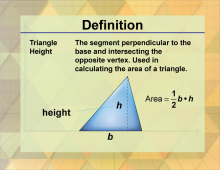
|
Definition--Triangle Concepts--Triangle Height | Triangle HeightTopicTriangles DefinitionThe height of a triangle is the perpendicular distance from a vertex to the line containing the opposite side, often used interchangeably with altitude. DescriptionThe height of a triangle, often used interchangeably with altitude, is a crucial concept in geometry. It represents the perpendicular distance from a vertex to the line containing the opposite side. This measurement is essential for calculating the area of a triangle, using the formula: Area= 1/2 × base × height |
Definition of a Triangle |
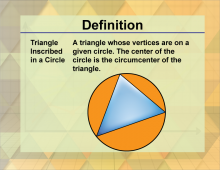
|
Definition--Triangle Concepts--Triangle Inscribed in a Circle | Triangle Inscribed in a CircleTopicTriangles DefinitionA triangle inscribed in a circle is a triangle whose vertices all lie on the circumference of the circle. DescriptionA triangle inscribed in a circle, also known as a circumtriangle, is a triangle whose vertices all lie on the circumference of the circle. The circle is called the circumcircle, and its center is the circumcenter of the triangle. |
Definition of a Triangle |
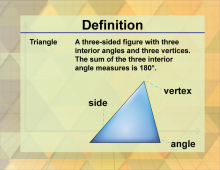
|
Definition--Triangle Concepts--Triangle, Definition 1 | Triangle, Definition 1TopicTriangles DefinitionA triangle is a polygon with three edges and three vertices. DescriptionA triangle is one of the simplest and most fundamental shapes in geometry, characterized by having three sides and three vertices. The sum of the interior angles of a triangle is always 180 degrees, which is a key property used in various geometric proofs and constructions. In real-world applications, triangles are used extensively in engineering, architecture, and design due to their inherent stability and strength. For example, triangular structures are often used in bridges and roof trusses to distribute weight evenly and provide support. |
Definition of a Triangle |
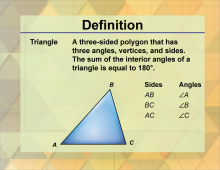
|
Definition--Triangle Concepts--Triangle, Definition 2 | Triangle, Definition 2TopicTriangles DefinitionA triangle is a three-sided polygon with three vertices and three angles. DescriptionA triangle is a three-sided polygon that is fundamental in the study of geometry. Each triangle has three vertices and three angles, and the sum of its interior angles is always 180 degrees. This property is crucial for understanding various geometric principles and solving related problems. |
Definition of a Triangle |
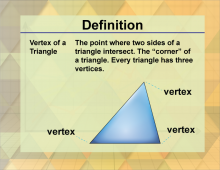
|
Definition--Triangle Concepts--Vertex of a Triangle | Vertex of a TriangleTopicTriangles DefinitionA vertex of a triangle is a point where two sides of the triangle meet. DescriptionA vertex of a triangle is one of the three points where the sides of the triangle intersect. Each triangle has three vertices, and these points are crucial for defining the shape and properties of the triangle. |
Definition of a Triangle |

|
INSTRUCTIONAL RESOURCE: Nspire App Tutorial: Constructing an Isosceles Triangle | In this Slide Show, we show how to construct an isosceles triangle. This presentation requires the use of the TI-Nspire iPad App. Note: the download is a PPT. |
Definition of a Triangle and Geometric Constructions with Triangles |

|
INSTRUCTIONAL RESOURCE: Nspire App Tutorial: The Perpendicular Bisectors of a Triangle | In this Slide Show, we show how to construct the perpendicular bisectors of the three sides of a triangle to show they intersect at a single point. This presentation requires the use of the TI-Nspire iPad App. Note: the download is a PPT. |
Definition of a Triangle and Geometric Constructions with Triangles |

|
INSTRUCTIONAL RESOURCE: TI-Nspire App Activity: Constructing an Isosceles Triangle | In this Slide Show, learn how to use the TI-Nspire App to construct an isosceles triangle. Note: The download is a PPT file. |
Definition of a Triangle and Geometric Constructions with Triangles |

|
Interactive Crossword Puzzle--Triangles | Interactive Crossword Puzzle--Triangles
This interactive crossword puzzle tests knowledge of key terms on the topic of triangles. This is part of a collection of math games and interactives. To see the complete collection of the games, click on this link. Note: The download is the teacher's guide.Related ResourcesTo see additional resources on this topic, click on the Related Resources tab. |
Definition of a Triangle |

|
Interactive Math Game: Math Riddles--Triangles | Interactive Math Game: Math Riddles--Triangles
In this Math Riddles Game, have your students review vocabulary around the topic of triangles. The Math Riddles games are useful for practicing: Math Vocabulary, Key Concepts, Critical Thinking. This is part of a collection of math games and interactives. To see the complete collection of the games, click on this link. Note: The download is the teacher's guide.Related ResourcesTo see additional resources on this topic, click on the Related Resources tab. |
Definition of a Triangle |
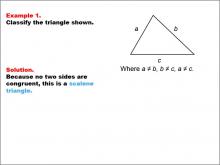
|
Math Example--Polygons--Triangle Classification: Example 1 | Math Example--Polygons--Triangle Classification: Example 1TopicTriangles DescriptionThis image shows a triangle with side lengths labeled as a, b, and c, where all sides are unequal. Based on the length of each side, the triangle is classified as scalene, as no two sides are congruent. Triangles are categorized based on side length (scalene, isosceles, equilateral) or angle measures (acute, obtuse, right). In this example, the scalene classification is determined by identifying that each side is a different length. The examples in this collection illustrate various classification rules based on both side and angle properties. |
Definition of a Triangle |
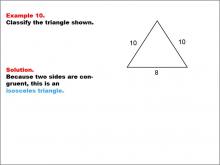
|
Math Example--Polygons--Triangle Classification: Example 10 | Math Example--Polygons--Triangle Classification: Example 10TopicTriangles DescriptionThis example presents a triangle with side lengths of 10, 10, and 8. Since two sides are congruent, the triangle is classified as isosceles. Triangle classification can be determined by side lengths or angle measures. Isosceles triangles have two equal sides or angles. Reviewing different examples assists students in identifying these types based on side or angle properties. Seeing multiple worked-out examples reinforces students’ ability to classify triangles by consistently applying classification rules. |
Definition of a Triangle |
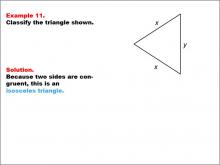
|
Math Example--Polygons--Triangle Classification: Example 11 | Math Example--Polygons--Triangle Classification: Example 11TopicTriangles DescriptionThis example shows a triangle with two sides labeled as x and a third side labeled y. Because two sides are congruent, the triangle is classified as isosceles. Triangles can be classified by their side lengths or angle measures. An isosceles triangle has two equal sides or angles, as seen in this example. Reviewing a series of examples helps students understand these classifications and recognize patterns in triangles. |
Definition of a Triangle |
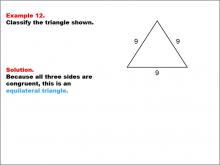
|
Math Example--Polygons--Triangle Classification: Example 12 | Math Example--Polygons--Triangle Classification: Example 12TopicTriangles DescriptionThis example shows a triangle with side lengths all equal to 9. Since all sides are congruent, the triangle is classified as equilateral. Triangles can be classified based on side or angle properties. An equilateral triangle has all sides and angles congruent. Viewing multiple examples reinforces students’ understanding of these classifications and enhances their ability to recognize triangle properties. Seeing several worked-out examples helps students understand and apply the rules consistently for classifying triangles. |
Definition of a Triangle |

|
Math Example--Polygons--Triangle Classification: Example 13 | Math Example--Polygons--Triangle Classification: Example 13TopicTriangles DescriptionThis example shows a triangle with three sides labeled as x, all equal in length. Since all sides are congruent, the triangle is classified as equilateral. Triangles can be categorized by side length or angle measures. An equilateral triangle has all congruent sides and angles. Reviewing multiple examples helps students recognize triangle classifications by observing side and angle patterns. Providing several examples reinforces students’ ability to consistently classify triangles based on the observed properties. |
Definition of a Triangle |
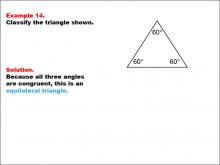
|
Math Example--Polygons--Triangle Classification: Example 14 | Math Example--Polygons--Triangle Classification: Example 14TopicTriangles DescriptionThis example shows a triangle with three angles, each measuring 60°. Since all angles are equal, the triangle is classified as equilateral. Triangle classification can be based on side lengths or angle measures. An equilateral triangle has all angles congruent. Reviewing examples like these helps students understand classification rules based on triangle properties. Multiple examples reinforce students' ability to identify triangle types consistently by observing angle or side characteristics. |
Definition of a Triangle |
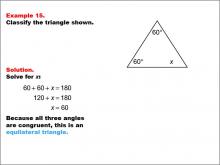
|
Math Example--Polygons--Triangle Classification: Example 15 | Math Example--Polygons--Triangle Classification: Example 15TopicTriangles DescriptionThis example presents a triangle with two angles labeled 60° and an unknown angle labeled x. Solving for x, we find it to be 60°, making all angles congruent and classifying the triangle as equilateral. Triangle classification can be determined by side length or angle measures. An equilateral triangle has all equal sides and angles. Observing multiple examples helps students apply these criteria consistently when classifying triangles. Seeing several worked examples helps students gain confidence in identifying triangles by recognizing congruent angles or sides. |
Definition of a Triangle |

|
Math Example--Polygons--Triangle Classification: Example 16 | Math Example--Polygons--Triangle Classification: Example 16TopicTriangles DescriptionThis example presents a triangle with three sides labeled as x, each equal in length. Since all three sides are congruent, the triangle is classified as equilateral. Triangles are categorized by their side lengths or angle measures. An equilateral triangle has all equal sides and angles, as seen in this example. Reviewing multiple examples reinforces students' understanding of the consistent characteristics that define each triangle type. Providing multiple worked-out examples helps students confidently apply classification rules to identify triangles by their properties. |
Definition of a Triangle |
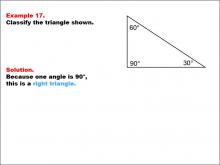
|
Math Example--Polygons--Triangle Classification: Example 17 | Math Example--Polygons--Triangle Classification: Example 17TopicTriangles DescriptionThis example shows a triangle with angles measuring 90°, 60°, and 30°. Since one angle is exactly 90°, the triangle is classified as a right triangle. Triangle classification often considers angle measures, with right triangles defined by having one 90° angle. Observing multiple examples allows students to consistently apply this classification rule. Reviewing various worked-out examples helps students solidify their understanding of identifying triangle types based on angle measurements. |
Definition of a Triangle |

|
Math Example--Polygons--Triangle Classification: Example 18 | Math Example--Polygons--Triangle Classification: Example 18TopicTriangles DescriptionThis example shows a triangle with two angles labeled 50° and 40° and an unknown angle x. Solving for x, we find it to be 90°, which classifies this as a right triangle. Triangles are classified by side lengths or angles, and a right triangle has a 90° angle. Examining examples like this helps students reinforce the criteria for identifying right triangles based on their angle properties. Seeing multiple worked-out examples enables students to apply classification rules more effectively and confidently. |
Definition of a Triangle |
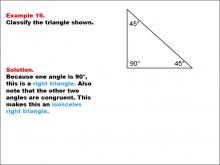
|
Math Example--Polygons--Triangle Classification: Example 19 | Math Example--Polygons--Triangle Classification: Example 19TopicTriangles DescriptionThis example presents a triangle with two congruent angles of 45° and one right angle of 90°. Because it has a 90° angle, the triangle is classified as a right triangle, and the two equal angles make it an isosceles right triangle. Triangle classification can involve side lengths or angles. A right triangle has a 90° angle, while isosceles triangles have two equal angles or sides. This example combines both classifications. Reviewing multiple examples helps students confidently apply the criteria to identify triangle types. |
Definition of a Triangle |

|
Math Example--Polygons--Triangle Classification: Example 2 | Math Example--Polygons--Triangle Classification: Example 2TopicTriangles DescriptionThis image shows a triangle with sides measuring 7, 8, and 9. The triangle is classified as scalene because each side has a different length, meaning no two sides are congruent. Triangles can be classified by examining their side lengths or angle measures. Scalene triangles, like the one shown, have no congruent sides, making them unique. This collection of examples helps students understand classification rules and visually identify different triangle types. |
Definition of a Triangle |
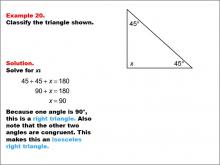
|
Math Example--Polygons--Triangle Classification: Example 20 | Math Example--Polygons--Triangle Classification: Example 20TopicTriangles DescriptionThis example shows a triangle with two known angles of 45° and an unknown angle x. Solving for x, we find it to be 90°, classifying this as a right triangle with two congruent angles, making it an isosceles right triangle. Triangle classification may be based on side lengths or angles. Right triangles have a 90° angle, while isosceles triangles have two equal sides or angles. Examples like this help students understand combined classifications. |
Definition of a Triangle |
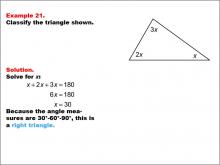
|
Math Example--Polygons--Triangle Classification: Example 21 | Math Example--Polygons--Triangle Classification: Example 21TopicTriangles DescriptionThis example shows a triangle with angles labeled as x, 2x, and 3x. Solving for x, we find that the angles are 30°, 60°, and 90°, classifying it as a right triangle. Triangle classification can involve angle measures or side lengths. Right triangles have one 90° angle, as seen here. Reviewing various examples supports students in consistently applying these classification rules. Observing multiple worked-out examples helps students gain confidence in identifying triangles based on the presence of specific angle measures. |
Definition of a Triangle |
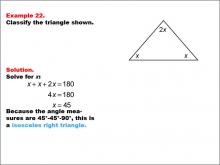
|
Math Example--Polygons--Triangle Classification: Example 22 | Math Example--Polygons--Triangle Classification: Example 22TopicTriangles DescriptionThis example shows a triangle with two equal angles labeled x and a third angle labeled 2x. Solving for x, we find the angles to be 45°, 45°, and 90°, classifying it as an isosceles right triangle. Triangles are classified by their angle measures or side lengths. Right triangles have a 90° angle, and isosceles triangles have two congruent angles. Reviewing examples like this one helps students understand combined classifications. |
Definition of a Triangle |

|
Math Example--Polygons--Triangle Classification: Example 23 | Math Example--Polygons--Triangle Classification: Example 23TopicTriangles DescriptionThis example shows a triangle with angles labeled x, 3x, and 5x. Solving for x, we find the angles to be 20°, 60°, and 100°, which classifies this triangle as obtuse because one of the angles is greater than 90°. Triangles can be classified by angle measures, with obtuse triangles defined as having one angle greater than 90°. Observing examples like this aids students in understanding how angle measures determine classifications. Providing multiple worked-out examples reinforces students' ability to consistently classify triangles based on angle properties. |
Definition of a Triangle |
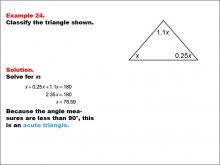
|
Math Example--Polygons--Triangle Classification: Example 24 | Math Example--Polygons--Triangle Classification: Example 24TopicTriangles DescriptionThis example shows a triangle with angles labeled as x, 0.25x, and 1.1x. Solving for x, we find that all angles are less than 90°, classifying the triangle as acute. Triangles are classified by their angle measures or side lengths, with acute triangles having all angles less than 90°. Reviewing examples like this helps students reinforce the criteria for classifying triangles based on angle sizes. Seeing multiple worked-out examples builds students' confidence in applying classification rules and identifying triangle types based on consistent properties. |
Definition of a Triangle |
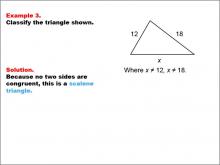
|
Math Example--Polygons--Triangle Classification: Example 3 | Math Example--Polygons--Triangle Classification: Example 3TopicTriangles DescriptionThis example shows a triangle with side lengths of 12, 18, and x, where x is not equal to 12 or 18. The triangle is classified as scalene because all three side lengths are different. Triangles are categorized by side length or angle. Scalene triangles, with all sides unequal, demonstrate a key classification type. Multiple examples help students recognize classification patterns for triangles based on side length or angle measure. Observing various worked-out examples reinforces consistent application of classification criteria, building student confidence in identifying triangle types. |
Definition of a Triangle |
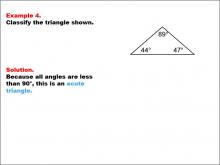
|
Math Example--Polygons--Triangle Classification: Example 4 | Math Example--Polygons--Triangle Classification: Example 4TopicTriangles DescriptionThis example displays a triangle with angles measuring 89°, 44°, and 47°. Since all angles are less than 90°, the triangle is classified as acute. Triangle classification can be based on side length or angle measures. Acute triangles have all angles less than 90°, as shown in this example. Reviewing multiple examples in this way helps students visually distinguish triangle types by angle. Providing varied worked-out examples solidifies students’ understanding of the criteria for each triangle type, enabling them to accurately identify triangles by their angle measures. |
Definition of a Triangle |
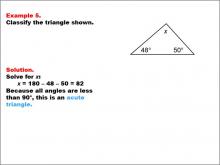
|
Math Example--Polygons--Triangle Classification: Example 5 | Math Example--Polygons--Triangle Classification: Example 5TopicTriangles DescriptionThis example presents a triangle with angles of 48°, 50°, and an unknown angle x. Solving for x, we find that x = 82°, meaning all angles are less than 90°, classifying it as acute. Triangles can be identified by their angles or side lengths. Acute triangles have all angles less than 90°, as seen here. Reviewing examples like this supports student understanding of angle-based classification. Seeing multiple worked examples helps students recognize patterns and confidently classify triangles based on established criteria. |
Definition of a Triangle |
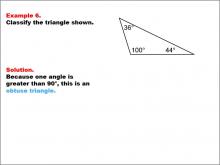
|
Math Example--Polygons--Triangle Classification: Example 6 | Math Example--Polygons--Triangle Classification: Example 6TopicTriangles DescriptionThis example shows a triangle with angles of 36°, 100°, and 44°. Because one of the angles is greater than 90°, this triangle is classified as obtuse. Triangles are classified by side lengths or angles. An obtuse triangle has one angle greater than 90°, as seen here. This collection of examples supports students in identifying and classifying triangles based on distinct angle measures. Seeing multiple worked-out examples reinforces students' understanding of classification rules, making it easier to recognize triangle types based on angle or side length. |
Definition of a Triangle |
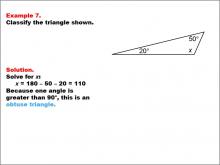
|
Math Example--Polygons--Triangle Classification: Example 7 | Math Example--Polygons--Triangle Classification: Example 7TopicTriangles DescriptionThis example presents a triangle with two known angles, 20° and 50°, and an unknown angle x. Solving for x, we find it to be 110°. Since one angle is greater than 90°, the triangle is classified as obtuse. Triangles can be classified by their angles, where obtuse triangles have one angle over 90°. Reviewing examples like this aids students in understanding classification based on angle measures. Seeing multiple examples reinforces the rules and helps students apply classification consistently and accurately. |
Definition of a Triangle |
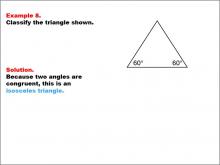
|
Math Example--Polygons--Triangle Classification: Example 8 | Math Example--Polygons--Triangle Classification: Example 8TopicTriangles DescriptionThis example shows a triangle with two angles, each measuring 60°. Since two angles are congruent, this triangle is classified as isosceles. Triangles can be categorized by side or angle properties. Isosceles triangles have two equal sides or two equal angles, as illustrated here. This collection of examples allows students to observe classifications and understand patterns in triangle properties. Examining multiple examples helps students confidently identify triangle types based on consistent characteristics. |
Definition of a Triangle |

|
Math Example--Polygons--Triangle Classification: Example 9 | Math Example--Polygons--Triangle Classification: Example 9TopicTriangles DescriptionThis example shows a triangle with two angles labeled x and one angle labeled y. Since two angles are congruent, the triangle is classified as isosceles. Triangles can be classified by side lengths or angle measures. Isosceles triangles, with two equal sides or angles, are common. Observing various examples helps students understand these classification criteria. Providing multiple examples allows students to identify patterns in side and angle relationships, reinforcing accurate triangle classification. |
Definition of a Triangle |

|
MATH EXAMPLES--Teacher's Guide: Triangle Classification | MATH EXAMPLES--Teacher's Guide: Triangle Classification
This set of tutorials provides 24 examples that show how to identify different types of triangles and how to solve for x using the properties of triangles. This is part of a collection of teacher's guides. To see the complete collection of teacher's guides, click on this link. Note: The download is a PDF file.Related ResourcesTo see resources related to this topic click on the Related Resources tab above. |
Definition of a Triangle |

|
MATH EXAMPLES--Triangle Classification | MATH EXAMPLES--Triangle Classification
This set of tutorials provides 24 examples that show how to identify different types of triangles and how to solve for x using the properties of triangles. NOTE: The download is a PPT file. |
Definition of a Triangle |

|
Video Transcript: Desmos Geometry Exploration: Classifying Triangles by Angle | This is the transcript for the video entitled, Desmos Geometry Exploration: Classifying Triangle by Angle. In this video tutorial triangles are classified by the types of angles that make up the triangle. Students are then shown how to construct such triangles using the Desmos geometry tools. The Desmos geometry tools can be found at www.desmos.com/geometry. The video is available for this tutorial at this link: https://www.media4math.com/library/video-tutorial-desmos-geometry-exploration-classifying-triangles-angle. Note: The download is a PDF file. Related ResourcesTo see additional resources on this topic click on the Related Resources tab above. Desmos CollectionTo see the complete collection of Desmos Resources go to this link: https://www.media4math.com/desmos-resources. Note: The download is a PDF file. |
Geometric Constructions with Triangles and Definition of a Triangle |

|
Video Transcript: Desmos Geometry Exploration: Classifying Triangles by Side Length | Video Transcript: Desmos Geometry Exploration: Classifying Triangles by Side Length
This is the transcript for the video entitled, Desmos Geometry Exploration: Classifying Triangle by Side. In this video tutorial triangles are classified by the side lengths that make up the triangle. Students are then shown how to construct such triangles using the Desmos geometry tools. |
Geometric Constructions with Triangles and Definition of a Triangle |

|
Video Transcript: Desmos Geometry Exploration: Triangle Basics | Video Transcript: Desmos Geometry Exploration: Triangle Basics
This is the transcript for the video entitled, Desmos Geometry Exploration: Triangle Basics. In this video tutorial the basics of triangles are explored. Students are then shown how to construct triangles using the Desmos geometry tools. This is part of a collection of video transcript for the video tutorial series on using the Desmos Geometry Tools. To see the complete collection of transcripts, click on this link. Note: The download is a PDF file. Video Transcript LibraryTo see the complete collection of video transcriptsy, click on this link. |
Definition of a Triangle and Geometric Constructions with Triangles |

|
Video Transcript: TI-Nspire Mini-Tutorial: Circumscribing a Circle about a Triangle | Video Transcript: TI-Nspire Mini-Tutorial: Circumscribing a Circle about a Triangle
This is the transcript for the TI-Nspire Mini-Tutorial entitled, Circumscribing a Circle about a Triangle. This is part of a collection of video transcripts for the video tutorial series on using the TI-Nspire Graphing Calculator. To see the complete collection of transcripts, click on this link. Note: The download is a PDF file. Video Transcript LibraryTo see the complete collection of video transcriptsy, click on this link. |
Geometric Constructions with Triangles |

|
Video Transcript: TI-Nspire Mini-Tutorial: Constructing the Circumcenter of a Triangle | Video Transcript: TI-Nspire Mini-Tutorial: Constructing the Circumcenter of a Triangle
This is the transcript for the TI-Nspire Mini-Tutorial entitled, Constructing the Circumcenter of a Triangle. This is part of a collection of video transcripts for the video tutorial series on using the TI-Nspire Graphing Calculator. To see the complete collection of transcripts, click on this link. Note: The download is a PDF file. Video Transcript LibraryTo see the complete collection of video transcriptsy, click on this link. |
Geometric Constructions with Triangles |

|
Video Transcript: TI-Nspire Mini-Tutorial: Constructing the Orthocenter of a Triangle | Video Transcript: TI-Nspire Mini-Tutorial: Constructing the Orthocenter of a Triangle
This is the transcript for the TI-Nspire Mini-Tutorial entitled, Constructing the Orthocenter of a Triangle. This is part of a collection of video transcripts for the video tutorial series on using the TI-Nspire Graphing Calculator. To see the complete collection of transcripts, click on this link. Note: The download is a PDF file. Video Transcript LibraryTo see the complete collection of video transcriptsy, click on this link. |
Geometric Constructions with Triangles |

|
Video Tutorial: Desmos Geometry Exploration: Classifying Triangles by Angle | Video Tutorial: Desmos Geometry Exploration: Classifying Triangles by Angle
TopicGeometry DescriptionThe video classifies triangles by their angles, highlighting acute, right, and obtuse triangles. Using Desmos, viewers construct and manipulate triangles to understand these categories. Key terms include equiangular, isosceles, and base angles. Applications involve creating different types of triangles and analyzing their angle properties. |
Definition of a Triangle and Geometric Constructions with Triangles |

|
Video Tutorial: Desmos Geometry Exploration: Classifying Triangles by Side Length | Video Tutorial: Desmos Geometry Exploration: Classifying Triangles by Side Length
TopicGeometry DescriptionTriangles are classified by side lengths: scalene (no congruent sides), isosceles (two congruent sides), and equilateral (three congruent sides). The video uses Desmos to explore these classifications. Key terms include congruent sides and scalene. Applications combine side and angle classifications for comprehensive triangle analysis. |
Geometric Constructions with Triangles |

|
Video Tutorial: Desmos Geometry Exploration: Triangle Basics | Video Tutorial: Desmos Geometry Exploration: Triangle Basics
TopicGeometry DescriptionTriangles are defined as three-sided closed figures with internal angles summing to 180°. The video demonstrates creating triangles with Desmos tools and exploring their properties. Key terms include vertices, line segments, and angles. Applications include constructing and measuring triangles to verify their angle sums. |
Definition of a Triangle and Geometric Constructions with Triangles |